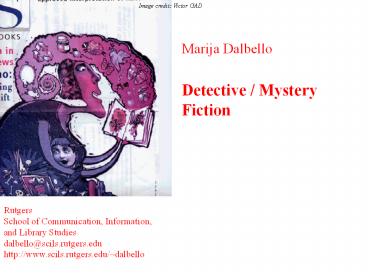Marija Dalbello PowerPoint PPT Presentation
Title: Marija Dalbello
1
Image credit Victor GAD
Marija Dalbello Detective / Mystery Fiction
Rutgers School of Communication, Information, and
Library Studies dalbello_at_scils.rutgers.edu http//
www.scils.rutgers.edu/dalbello
2
Detective / Mystery Fiction ______________________
_________________ Detective fiction is an
art of symmetry, it seeks the appearance of
logical necessity, like classical tragedy, and
like tragedy, it seeks the unity of place - the
locked room, the ship, or train in motion.
(Barzun, in Dove, 4)
3
Detective / Mystery Fiction ______________________
_________________ Horizons of expectation (W.
Iser) Interpretation is pre-structured
situated nature of interpretation in the readers
world of past experiences Historical development
of a genre (and the difference bw the novice and
the veteran reader) affect the horizon of
expectation (text reader involved) first
reading of a text becomes a basis for the
horizon of the second reading of the text
negativity are unformulated aspects of the text
(p. 145) that provide opportunities for a reader
to create interpretations of what is to
come Reading is the act of communication bw the
text and the reader (reading different from the
usual dyadic conversation because there is an
absence of the regulative context to assist the
understanding of the text text is interpretable
in several different ways) text is not object
but product of interpretation 1930s-1940s New
Criticism (scientific approach to text, without
considering the context) Reader-response builds
on Iser Jauss (reception theory) developed by
Stanley Fish influential in the last 30 years
meaning is not discovered in the text but is
generated by the reading of it text-centered
study of reading process elitist
4
Detective / Mystery Fiction ______________________
_________________ Hermeneutic specialization One
of the axioms of the detective story is its basic
purpose (its hermeneutic specialization) which
gives precedence to the readers need to find out
about what happens next. Most stories have
hermeneutic qualities but in the detective story
the reader asks of any information how it fits
in and how it will all come out. Detective
fiction is rich in structured blanks which
indicate patterns in the text Blanks are
programmed (supplied with suggestions related to
later developments Is this fact important?)
5
Detective / Mystery Fiction ______________________
_________________ Play (H-G. Gadamer) absence of
stress / presence of strain Gadamerian concept
of play transformed into art both the crossword
puzzle and the detective novel are free of
stress, each offers the reader a task or set of
related tasks, both are shaped by convention, and
neither has any goal beyond itself. (p.
3) Through play, the story becomes the work of
art, it is transformed into structure
Detective story refuses to go beyond the bounds
of play (not about the real world) Classic
(determined symmetrical, disciplined reading)
hard-boiled (includes goal-free nonhermeneutic
material)
6
Detective / Mystery Fiction ______________________
_________________ History / types formal-problem
detective story (E.A. Poe, C. Doyle) problem
solved by means of reason (golden age of mystery
1920s-1930s, bw the wars) hard-boiled private
eye story (D. Hammett, R. Chandler) problem
solved by means of pursuit and conflict rather
than reason (an American invention,
1940s-1950s) gothic and romantic suspense
involving crime (1960s and 1970s) decline of the
mystery genre? (1970s efforts of the Mystery
Writers of America Sisters in Crime formed in
1985 by Sara Paretsky to promote gender equality
in crime publishing) revival (1980s cozier
mysteries placing relationship on sleuths
personal relationships) diversity and popularity
of the genre (1990s detectives
ethnic/male/female/gay, genre blending with
romance, sf, historicals) police procedurals
(more recent transformation, see A.A. Berger)
the detective is an expert rules of the police
department, can be either hard boiled or cozy
7
Detective / Mystery Fiction ______________________
_________________ History / types Prototypical
detective story Poe The Murders in the Rue
Morgue (Dove, p. 23) Rules that determine the
genre (formula) 1. Detective-protagonist is the
prime mover of the action of the narrative 2.
The detection-plot supplies the major theme of
the story minor themes may exist but the
detection is always basic blanks are the
propellants of the text indicating pattern and
direction 3. There is the problem to be solved,
invariably represented as insoluble 4. There is
the solution, which is always reached before the
story ends 7-step basic plot of all detective
fiction problem, first solution, complication,
period of gloom, dawning light, solution,
explanation cf. Knight McKnight hermeneutic
interpretation of clues in terms of action of
large scale red herring (first puzzle) / focal
mystery, with the ironic connection between the
two test scenario (red herring) / solution
(focal mystery)
8
Detective / Mystery Fiction ______________________
_________________ Convention / Invention
(p.75-76) constitutive conventions define a
genre and are essential to it (a story that does
not have a detective is not a detective story)
(p. 76-77) the detectives story the centrality
of the main plot the problem is not only a
mystery to be solved but is doubly wrapped and
deeply veiled closure is sacralized-it must not
be given away at any cost (in some cases the
murder need not be solved but there must be a
satisfying solution) regulative conventions
characterize a genre but are not essential to it
there is almost always a murder in the detective
story (but it is possible to have a detective
story without a murder) recurrent stereotypes
(Most Likely Suspect, the Most Likely Victim, the
Death Warrant)

